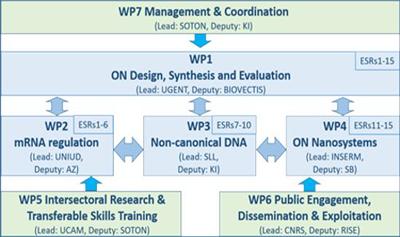
WP structure of OLIGOMED
Integrated workpackages form the basis of R&D, training, dissemination and management of our network.
BeneficiariesIn order to achieve the overarching aims and to successfully deliver a flexible platform technology that can be adapted to different medical problems, OLIGOMED has defined research objectives addressed by four interlocked Research & Development (R&D) work packages (WPs). These are briefly described below.
The R&D WPs consist of:
The WPs comprise design, synthesis, analysis, delivery and therapy.
Targets are cancer, Huntington's Disease and cardiovascular diseases.
Three additional WPs cover logistics in training, dissemination and management.

Integrated workpackages form the basis of R&D, training, dissemination and management of our network.
BeneficiariesThis overarching WP includes all aspects of ON chemistry and biology; functional ONs are key to the platform’s success; targeted delivery will be a major focus point.
This WP will employ all ESRs, where they will perform the design and method development of building blocks and especially ON constructs for use in WP2-4 and share the knowledge across the consortium. It includes training in making, analysing and using ONs (tools), and in the design of the targets (strategy).
WP1 is led by UGENT and Biovectis.
In addition, both up and down regulation will be attempted by manipulating the cap-independent IRES function in oncogenes as a new modality. Target diseases are HD, cancer, and cardiovascular diseases.
This WP will employ ESRs 1-6.
WP2 is led by UNIUD and AZ.
This WP entails two approaches: triple helix and GQ formation.
The former is part of a therapy discovery program addressing HD and Friedreichs ataxia (FRDA).
Modified GQs with increased stability and defined folding will be used as decoy to target telomerase activity and to manipulate gene-expression in systems where GQs are essential regulatory parts; both are valid targets for cancer treatment.
This WP will employ ESRs 7-10.
WP3 is led by SLL and KI.
We will use DNA and RNA based self-assembled nanopores (NP) that embed into membranes and lead to cell death, or lead to scaffolds that deliver ONs onto the cell cytoplasm.
Conjugated systems of the NP combined with cell targeting systems, immune stimulants, and chromophores for photodynamic therapy will form a combination therapy in a novel and truly modular system
This WP will employ ESRs 11-15.
WP4 is led by INSERM and SB.
Beneficiary acronyms:
| SOTON | University of Southampton | UGENT | Universiteit Gent |
| CNRS | Centre National de la Recherche Scientifique | AZ | AstraZeneca |
| KI | Karolinska Instituted | UNIUD | Università degli Studi di Udine |
| BIOVECTIS | BioVectis | UCAM | University of Cambridge |
| SLL | Stockholms Läns Landsting | RISE | Research Institutes of Sweden |
| INSERM | Université de Bordeaux | SB | Sixfold Bioscience |